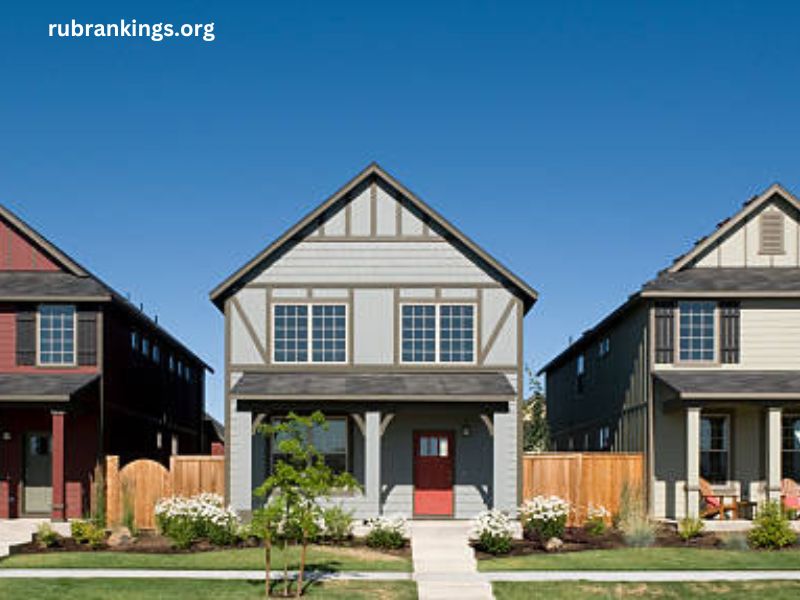In the world of real estate, terminology can vary widely depending on region, type of property, and architectural style. One such term that frequently surfaces in urban settings is “row,” often used in conjunction with “row house” or “row home.” Row homes, a prevalent feature in many cities, have been a cornerstone of affordable housing and dense, efficient land use for centuries. But what exactly is a row home, and what does the term “row” mean in real estate? This article explores the history, architecture, and modern implications of row homes, as well as their role in the real estate market today.
What Is a Row Home?
A row home, also known as a terraced house in the United Kingdom, refers to a series of identical or nearly identical homes built side by side, sharing one or more walls with neighboring homes. These houses typically line up in a straight “row,” hence the term. They are especially common in urban areas, where maximizing land use and creating affordable housing options have always been priorities.
While each unit in a row home shares walls with its neighbors, it usually has its own distinct entrance, facade, and, often, a small front yard or garden. Typically, row homes are two to four stories tall, with narrow floor plans designed to fit as many homes as possible within a confined urban space.
Key Features of Row Homes
- Shared Walls: Row homes are characterized by their shared walls, known as “party walls,” which connect one home to the next. These shared walls reduce the need for additional land space and construction materials, making row homes more economical than detached single-family homes.
- Compact Design: These homes tend to be narrow and extend vertically. The average width of a row home is usually between 15 and 20 feet, though this can vary depending on the city and time period of construction.
- Private Entrances: Unlike apartment buildings where multiple units share common entrances and hallways, each row home has its own private entry from the street.
- Urban Placement: Row homes are most commonly found in urban areas, especially in cities with long histories of dense residential construction, like Philadelphia, Boston, and San Francisco in the United States, or London and Paris in Europe.
- Individual Ownership: Each row home is individually owned, and although they share walls, each property is legally separate.
A Brief History of Row Homes
Row homes have a long history, dating back to the 17th century in Europe. They were initially built as a solution to overcrowding in rapidly growing cities, especially in London and other parts of England. As cities expanded during the Industrial Revolution, row homes became a practical way to house the working class, who needed affordable homes close to urban centers.
The popularity of row homes spread to other parts of the world, particularly to North America, where they became a staple of city architecture in the 19th and early 20th centuries. In the U.S., cities like Baltimore, Philadelphia, and New York saw row homes as an effective means of providing middle- and lower-income families with affordable housing options.
In many cities, row homes were built in large quantities by developers who used a uniform architectural style to create cohesive blocks or neighborhoods. These homes were often constructed with brick or stone facades, which lent them durability and a distinctive appearance.
Types of Row Homes
Row homes can be found in various forms and architectural styles, influenced by the time and location of their construction. Here are a few common types:
1. Victorian Row Homes
- Built primarily during the late 19th century, these row homes often feature ornate details, such as decorative cornices, bay windows, and intricate moldings. Victorian row homes are common in cities like San Francisco and London, where they continue to be highly sought after for their historical charm.
2. Federal Style Row Homes
- This style emerged in the United States during the early 19th century and is characterized by a more straightforward and symmetrical design. Federal-style row homes typically feature brick facades, tall windows, and a minimal amount of decorative detailing.
3. Modern Row Homes
- Contemporary row homes often blend modern architectural elements with the traditional row home format. These homes may include large glass windows, sleek lines, and energy-efficient features while maintaining the shared-wall layout that defines row housing.
4. Townhouses
- The terms “row house” and “townhouse” are sometimes used interchangeably. However, townhouses can also refer to row homes built with a bit more luxury, offering more space and higher-end finishes. Townhouses are common in suburban and urban settings alike and are often seen as a step up from traditional row homes in terms of size and amenities.
The Role of Row Homes in Urban Planning
Row homes play a crucial role in urban planning and development. As cities continue to grow, the demand for efficient, affordable housing remains high. Row homes provide a solution that allows cities to accommodate more residents without sprawling outward into suburban or rural areas.
1. Efficient Land Use
- Row homes maximize the use of available land by eliminating the space that would typically be needed for side yards in detached single-family homes. By building homes in a row with shared walls, developers can fit more homes into a given area, which is especially important in cities where land is scarce and expensive.
2. Affordable Housing
- The compact nature and shared construction of row homes often make them more affordable than detached homes. This affordability has made row homes a popular choice for first-time homebuyers, middle-class families, and those looking to live in urban areas without the higher price tag of larger homes.
3. Community Building
- Row homes create a sense of community by fostering close-knit neighborhoods. Because the homes are built so closely together, residents are more likely to interact with their neighbors, creating a strong sense of community and shared responsibility for the upkeep of their block.
4. Environmental Benefits
- Row homes are more energy-efficient than detached homes due to their shared walls, which reduce heat loss during the winter and help maintain cool temperatures in the summer. This efficiency not only lowers energy costs for homeowners but also reduces the overall environmental impact of the homes.
Challenges of Living in Row Homes
While row homes offer many benefits, they also come with certain challenges that potential buyers should consider:
1. Limited Space
- Due to their narrow design, row homes often have limited square footage compared to detached homes. While this may not be an issue for small families or individuals, larger families might find the space restrictive.
2. Noise
- Shared walls mean that noise can sometimes travel between homes, leading to potential disturbances from neighbors. However, modern construction methods and soundproofing techniques have mitigated this issue in many newer row homes.
3. Lack of Privacy
- With homes built so closely together, privacy can be an issue for some residents, particularly in front-facing windows and outdoor spaces. Some homeowners may feel that they are always in close proximity to their neighbors, which can be a drawback for those who prefer more secluded living environments.
The Future of Row Homes
As cities continue to grow and face challenges related to housing affordability and land use, row homes are likely to remain a popular choice for urban planners and developers. In many cities, older row homes are being renovated and modernized, preserving their historical character while incorporating contemporary amenities.
Additionally, eco-conscious buyers are increasingly drawn to row homes for their energy efficiency and sustainable design. As green building practices become more widespread, we may see row homes equipped with solar panels, green roofs, and other environmentally friendly features.
Conclusion
A “row” in real estate refers to a series of homes built side by side, sharing walls, and forming a row-like arrangement. Row homes, with their historical roots and enduring relevance, remain an integral part of urban landscapes. They offer an efficient, affordable housing solution while fostering a sense of community. As urban areas continue to grow and evolve, the row home is likely to remain a fixture of city living, offering a blend of practicality, affordability, and style for generations to come.



